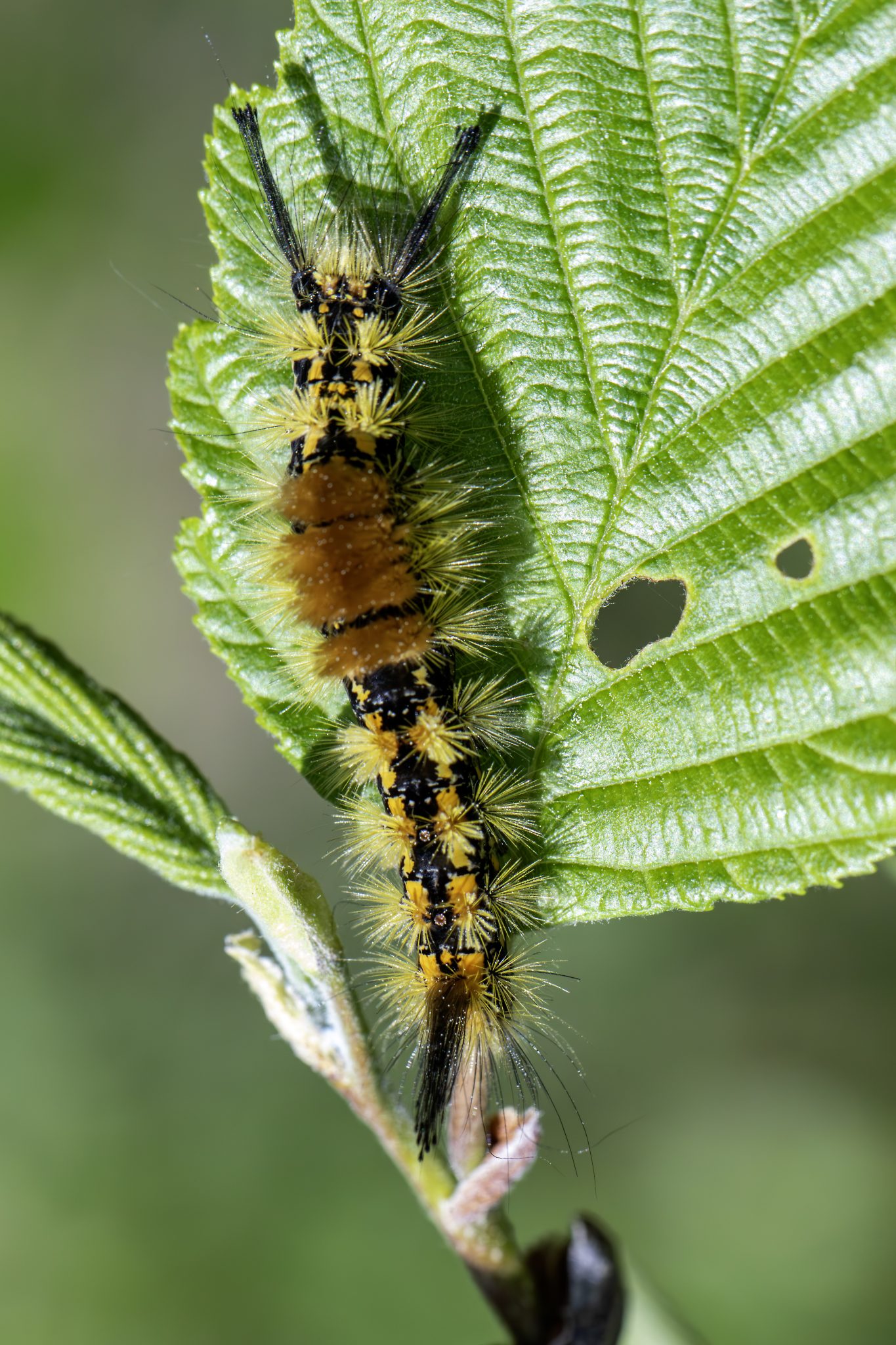The Western Tussock Moth, Orgyia vetusta, is a striking and fuzzy moth species in the family Erebidae, subfamily Lymantriinae (commonly known as tussock moths). It is native to western North America, with its range extending from British Columbia through California and occasionally found inland. This species is well known for its hairy caterpillars and for the wingless adult females—a fascinating trait among some tussock moths.
🐛 Identification
Caterpillar (Larva)
- Length: Up to 35 mm
- Color: Dark body with bold, colorful tufts of yellow, orange, or white hairs
- Features:
- Four prominent tussocks (tufts) on the back
- Bright red/orange spots
- Long black pencil-like hairs at both ends
- Highly irritating hairs that can cause skin irritation
Adult Male
- Wingspan: About 25–30 mm
- Color: Brownish-gray with darker and lighter patterns
- Antennae: Feathery (bipectinate), used to locate females by scent
- Flight: Active fliers, especially during the day
Adult Female
- Wingless: Females remain in their cocoon
- Color: Grayish, fuzzy body
- Behavior: Attracts males by releasing pheromones
- Egg-laying: Lays eggs on or near her cocoon, then dies shortly after
🌿 Habitat & Host Plants
- Habitat:
Coastal forests, woodlands, gardens, and urban areas - Host plants:
A wide variety of deciduous trees and shrubs, including:- Oak
- Willow
- Apple
- Cherry
- Rose
- Other native and ornamental trees
🔁 Life Cycle
- Eggs:
Laid on cocoon in masses; overwinter and hatch in spring - Larvae:
Feed voraciously on leaves and pass through several molts - Pupation:
Occurs in a silken cocoon spun in protected places (bark crevices, leaves, structures) - Adults:
Emerge in late summer or autumn; males seek out females for mating
⚠️ Human Interaction
- Caution: Caterpillar hairs can cause skin rashes or allergic reactions in sensitive individuals.
- Pest status: In large numbers, larvae can defoliate trees, but outbreaks are usually localized and short-lived.
🌍 Distribution
- Found along the west coast of North America:
- From southern British Columbia through Washington, Oregon, and California
- Occasionally seen in parts of Nevada, Idaho, and Utah
📌 Summary
The Western Tussock Moth (Orgyia vetusta) is a fascinating species notable for its striking caterpillars, wingless females, and diverse host range. While it can sometimes be a minor pest, it plays an important role in local ecosystems and is a captivating example of moth diversity in western North America. If you spot its fuzzy caterpillars, admire from a distance—they’re beautiful, but best left untouched!
Western Tussock Moth (Orgyia vetusta)
The Western Tussock Moth, Orgyia vetusta, is a striking and fuzzy moth species in the family Erebidae, subfamily Lymantriinae (commonly known as tussock moths). It is native to western North America, with its range extending from British Columbia through California and occasionally found inland. This species is well known for its hairy caterpillars and for the wingless adult females—a fascinating trait among some tussock moths.
🐛 Identification
Caterpillar (Larva)
- Length: Up to 35 mm
- Color: Dark body with bold, colorful tufts of yellow, orange, or white hairs
- Features:
- Four prominent tussocks (tufts) on the back
- Bright red/orange spots
- Long black pencil-like hairs at both ends
- Highly irritating hairs that can cause skin irritation
Adult Male
- Wingspan: About 25–30 mm
- Color: Brownish-gray with darker and lighter patterns
- Antennae: Feathery (bipectinate), used to locate females by scent
- Flight: Active fliers, especially during the day
Adult Female
- Wingless: Females remain in their cocoon
- Color: Grayish, fuzzy body
- Behavior: Attracts males by releasing pheromones
- Egg-laying: Lays eggs on or near her cocoon, then dies shortly after
🌿 Habitat & Host Plants
- Habitat:
Coastal forests, woodlands, gardens, and urban areas - Host plants:
A wide variety of deciduous trees and shrubs, including:- Oak
- Willow
- Apple
- Cherry
- Rose
- Other native and ornamental trees
🔁 Life Cycle
- Eggs:
Laid on cocoon in masses; overwinter and hatch in spring - Larvae:
Feed voraciously on leaves and pass through several molts - Pupation:
Occurs in a silken cocoon spun in protected places (bark crevices, leaves, structures) - Adults:
Emerge in late summer or autumn; males seek out females for mating
⚠️ Human Interaction
- Caution: Caterpillar hairs can cause skin rashes or allergic reactions in sensitive individuals.
- Pest status: In large numbers, larvae can defoliate trees, but outbreaks are usually localized and short-lived.
🌍 Distribution
- Found along the west coast of North America:
- From southern British Columbia through Washington, Oregon, and California
- Occasionally seen in parts of Nevada, Idaho, and Utah
📌 Summary
The Western Tussock Moth (Orgyia vetusta) is a fascinating species notable for its striking caterpillars, wingless females, and diverse host range. While it can sometimes be a minor pest, it plays an important role in local ecosystems and is a captivating example of moth diversity in western North America. If you spot its fuzzy caterpillars, admire from a distance—they’re beautiful, but best left untouched!
Views: 643
Subscribe to the newsletter:
